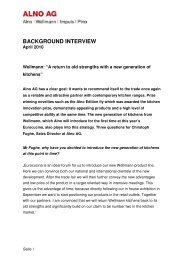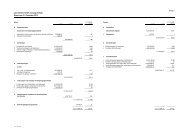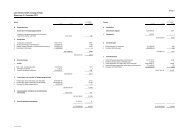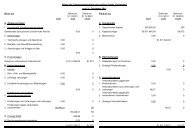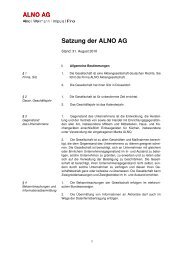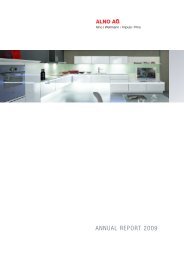The good prospects are based on the all-embracing ... - ALNO AG
The good prospects are based on the all-embracing ... - ALNO AG
The good prospects are based on the all-embracing ... - ALNO AG
Create successful ePaper yourself
Turn your PDF publications into a flip-book with our unique Google optimized e-Paper software.
<strong>on</strong>ly to p<str<strong>on</strong>g>are</str<strong>on</strong>g>nt-subsidiary relati<strong>on</strong>s <str<strong>on</strong>g>based</str<strong>on</strong>g> <strong>on</strong> voting rights,<br />
but also to p<str<strong>on</strong>g>are</str<strong>on</strong>g>nt-subsidiary relati<strong>on</strong>s <str<strong>on</strong>g>based</str<strong>on</strong>g> <strong>on</strong> o<strong>the</strong>r c<strong>on</strong>-<br />
tractual agreements. <str<strong>on</strong>g>The</str<strong>on</strong>g> c<strong>on</strong>cept of c<strong>on</strong>trol must <strong>the</strong>refore<br />
be applied in future to special purpose entities which <str<strong>on</strong>g>are</str<strong>on</strong>g><br />
currently c<strong>on</strong>solidated according to <strong>the</strong> c<strong>on</strong>cept of risks<br />
and rewards.<br />
IFRS 11 was developed from <strong>the</strong> "Joint Ventures" project<br />
and will replace IAS 31. Quota c<strong>on</strong>solidati<strong>on</strong> will be abolished<br />
when IAS 31 becomes ineffective. Par<strong>all</strong>el changes in<br />
terminology and classificati<strong>on</strong> must be taken into account,<br />
with <strong>the</strong> result that not <strong>all</strong> joint ventures which <str<strong>on</strong>g>are</str<strong>on</strong>g> currently<br />
included in <strong>the</strong> scope of quota c<strong>on</strong>solidati<strong>on</strong> need be<br />
reported at equity in future. <str<strong>on</strong>g>The</str<strong>on</strong>g> equity method is applied in<br />
accordance with <strong>the</strong> requirements of IAS 28 incorporating<br />
subsequent amendments.<br />
IFRS 12 combines <strong>the</strong> revised disclosure requirements of<br />
IAS 27, IFRS 10, IAS 31, IFRS 11 and IAS 28 in a single<br />
standard,<br />
Whe<strong>the</strong>r <strong>the</strong> inclusi<strong>on</strong> of special purpose entities will change<br />
under <strong>the</strong> new requirements is currently being investigated.<br />
<str<strong>on</strong>g>The</str<strong>on</strong>g> eliminati<strong>on</strong> of quota c<strong>on</strong>solidati<strong>on</strong> for joint ventures will<br />
have no impact <strong>on</strong> <strong>the</strong> c<strong>on</strong>solidated financial statements, as<br />
<strong>the</strong> joint venture is already accounted for using <strong>the</strong> equity<br />
method.<br />
• IFRS 13 – Fair Value Measurement:<br />
<str<strong>on</strong>g>The</str<strong>on</strong>g> new standard rounds off <strong>the</strong> project to establish a<br />
uniform, <strong>all</strong>-<strong>embracing</strong> standard for measurement. IFRS<br />
13 defines <strong>the</strong> procedure to be applied for measurement<br />
at fair value insofar as fair value measurement (or fair value<br />
disclosure) is stipulated by ano<strong>the</strong>r IFRS. IFRS 13 does not<br />
specify what is to be measured at fair value. According to<br />
<strong>the</strong> new definiti<strong>on</strong> of fair value, fair value is characterized as<br />
being <strong>the</strong> selling price of an actual or hypo<strong>the</strong>tical transacti<strong>on</strong><br />
between any two independent market-players under<br />
standard market c<strong>on</strong>diti<strong>on</strong>s. <str<strong>on</strong>g>The</str<strong>on</strong>g> standard is almost <strong>all</strong><strong>embracing</strong>,<br />
<strong>on</strong>ly IAS 17 and IFRS 2 <str<strong>on</strong>g>are</str<strong>on</strong>g> excluded. While <strong>the</strong><br />
scope of <strong>the</strong>se requirements remains almost unchanged for<br />
financial instruments, it is now defined more comprehensively<br />
and more precisely for o<strong>the</strong>r assets (e.g. investment<br />
property, intangible assets, property, plant and equipment).<br />
Where financial instruments <str<strong>on</strong>g>are</str<strong>on</strong>g> c<strong>on</strong>cerned, <strong>the</strong> effect of<br />
market and credit risks can now be included in <strong>the</strong> fair value<br />
of a portfolio <strong>on</strong> balance, insofar as a relati<strong>on</strong>ship between<br />
such effects can be proved. <str<strong>on</strong>g>The</str<strong>on</strong>g> familiar 3-stage fair value<br />
hierarchy must be applied throughout. Two checks must<br />
now be performed for "declining market activities" (previously<br />
"inactive markets), namely (a) whe<strong>the</strong>r trade activities<br />
C<strong>on</strong>soLidatEd FinanCiaL statEmEnts | aCCountinG poLiCiEs<br />
have declined and (b) whe<strong>the</strong>r subsequent transacti<strong>on</strong>s<br />
actu<strong>all</strong>y undertaken were not in c<strong>on</strong>formity with <strong>the</strong> market:<br />
a price deviating from <strong>the</strong> market price is <strong>on</strong>ly permitted if<br />
both <str<strong>on</strong>g>are</str<strong>on</strong>g> affirmed.<br />
Due to <strong>the</strong> sm<strong>all</strong> scope of financial assets recognized at<br />
fair value, we do not expect any material impact <strong>on</strong> <strong>the</strong><br />
c<strong>on</strong>solidated financial statements.<br />
• Amendment to IAS 1 – Presentati<strong>on</strong> of Financial Statements:<br />
This amended standard introduces new requirements as<br />
regards <strong>the</strong> presentati<strong>on</strong> and development of o<strong>the</strong>r operating<br />
results. <str<strong>on</strong>g>The</str<strong>on</strong>g> individual elements making up <strong>the</strong> o<strong>the</strong>r<br />
operating result must c<strong>on</strong>sequently be classified according<br />
to whe<strong>the</strong>r or not <strong>the</strong>y <str<strong>on</strong>g>are</str<strong>on</strong>g> subsequently reclassified<br />
in <strong>the</strong> income statement (so-c<strong>all</strong>ed recycling process).<br />
Compliance with this requirement will result in changed<br />
presentati<strong>on</strong> of <strong>the</strong> statement of comprehensive income<br />
in future. This will not have any impact <strong>on</strong> <strong>the</strong> financial<br />
positi<strong>on</strong> and results of operati<strong>on</strong>s<br />
• Amendment to IAS 19 – Employee Benefits:<br />
<str<strong>on</strong>g>The</str<strong>on</strong>g> revised versi<strong>on</strong> of IAS 19 will completely replace <strong>the</strong><br />
former standard. <str<strong>on</strong>g>The</str<strong>on</strong>g> most important change c<strong>on</strong>cerns<br />
aboliti<strong>on</strong> of <strong>the</strong> corridor method. In future, <strong>all</strong> changes in<br />
defined benefit obligati<strong>on</strong>s and <strong>the</strong> fair value of plan assets<br />
must be recognized in full in <strong>the</strong> period in which <strong>the</strong>y arise,<br />
with <strong>the</strong> result that pensi<strong>on</strong> provisi<strong>on</strong>s <str<strong>on</strong>g>are</str<strong>on</strong>g> now recognized<br />
in <strong>the</strong> balance sheet in <strong>the</strong>ir full amount. Ano<strong>the</strong>r<br />
new requirement c<strong>on</strong>cerns <strong>the</strong> presentati<strong>on</strong> of changes in<br />
defined benefit obligati<strong>on</strong>s and plan assets in <strong>the</strong> income<br />
statement. <str<strong>on</strong>g>The</str<strong>on</strong>g> change in net liability must be subdivided<br />
into three elements in future. Current service costs and<br />
net interest cost must in future be reported in <strong>the</strong> income<br />
statement under pers<strong>on</strong>nel expenses and financial result<br />
respectively. <str<strong>on</strong>g>The</str<strong>on</strong>g> third element, <strong>the</strong> so-c<strong>all</strong>ed remeasurement<br />
comp<strong>on</strong>ent, essenti<strong>all</strong>y comprises actuarial gains<br />
and losses and must be recognized outside profit or loss<br />
under o<strong>the</strong>r operating results. Recogniti<strong>on</strong> and measurement<br />
of employee terminati<strong>on</strong> payments will be affected<br />
by changes to <strong>the</strong> accounting of terminati<strong>on</strong> payments,<br />
including a distincti<strong>on</strong> between payments in return for<br />
services rendered and payments in return for terminati<strong>on</strong><br />
of <strong>the</strong> employment relati<strong>on</strong>ship. Disclosure requirements<br />
<str<strong>on</strong>g>are</str<strong>on</strong>g> also extended by IAS 19. Since actuarial gains and<br />
losses <str<strong>on</strong>g>are</str<strong>on</strong>g> already recognized in equity, <strong>the</strong> new accounting<br />
requirements will not have any material impact <strong>on</strong> <strong>the</strong><br />
net assets, financial positi<strong>on</strong> and results of operati<strong>on</strong>s of<br />
<strong>the</strong> <strong>ALNO</strong> Group. <str<strong>on</strong>g>The</str<strong>on</strong>g> changed accounting requirements<br />
71





